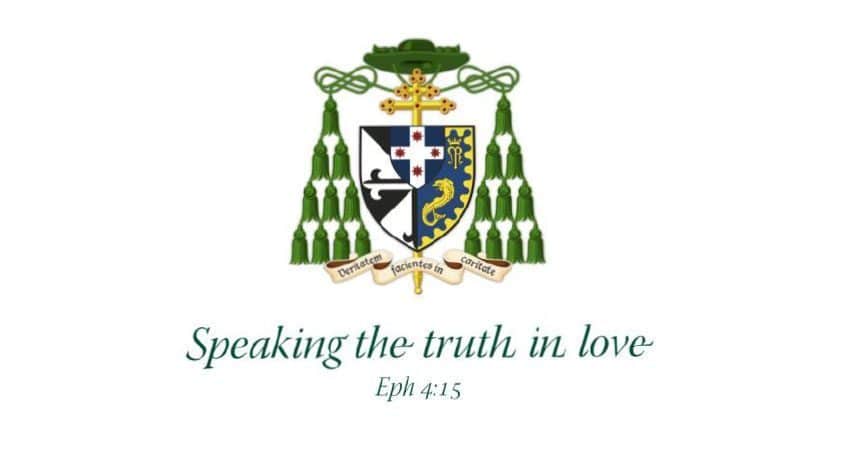HOMILY FOR THURSDAY 4TH WEEK OF ADVENT

Final Night of the Christmas Novena of (Simbang Gabi or Cockcrow) Masses – Our Lady of Fatima, Kingsgrove
If ever you get to travel overseas again, and you find yourself in Florence, I suggest you stop at the Dominican Priory of San Marco. There between 1438 and 1452 the great Dominican painter, Blessed Fra Angelico, and team made over fifty frescoes and altarpieces, many of which are still in situ, making it the largest surviving group of related works by any Italian renaissance artist. In the public church Angelico painted a tremendous Madonna and Child with saints; in the semi-public corridors, chapter-room, refectory and cloister some grand crucifixions, an Annunciation and another Madonna; and in each friar’s private cell a scene from the life of Christ. Nowadays it’s a state museum, and they’ve added to the collection other works by the same painter created for elsewhere, including a 25cm square panel from the predella of a lost altarpiece of St John the Baptist. It depicts today’s Gospel scene of The Naming of the Baptist (Lk 1:57-66).
Five women attend upon Zechariah to ask what name should be given the child; though Elizabeth had already named him John, her in-laws have objected that this name is unprecedented in their family. But we know from a previous scene in the Gospel (Lk 1:5-25) that the angel Gabriel had appeared to Zechariah to tell him that his childless wife Elizabeth would in her old age bear him a son, what the boy’s identity and mission would be, and what he should name him. The Hebrew name Yohanan (יוֹחָנָן) meant graced by God.
So fearful and disbelieving was Zechariah about all this that he was struck dumb. In our painting the woman closest to Zechariah holds what looks like an umbrella but is in fact a renaissance inkwell. From it the seated old man Zechariah has taken ink to pen so he can write the child’s name on a tablet. Elizabeth holds the baby, presenting him to the boy’s father. Unlike the overgrown babini of most renaissance paintings, this John has a tiny head and body. Was he born severely premature? Was the painter Fra Angelico so secluded in his monastery that he didn’t know much about babies? Was it an inferior painter from Angelico’s team? What’s going on here?
Well, this much is clear: Fra Angelico painted many life-like babies in his various Madonnas and Nativities and knew perfectly well how big they are. The altarpiece from the church at San Marco is one such example. Was he perhaps making some theological point in depicting the new-born John so diminutively?
Let’s look at who John was and what was his mission. From ancient times he was called John the Precursor, the one who came before, the one who pointed out. At the Visitation the unborn John’s movement draws his pregnant mother Elizabeth’s attention to Mary as Mother of the Lord. It gives Elizabeth goosebumps of the Holy Spirit and she whoopees part of the Hail Mary (Lk 1:41-44). As we heard in our Gospel today, his father’s speech returned when he obeyed the direction to call him John; in the verses that follow our pericope he sings the Benedictus, declaring that the mighty Saviour from the house of David so long promised by the prophets was imminent and his little child would make straight His ways (Lk 1:67-80). And as an adult John was yet again a finger pointed towards Jesus, whom he identified as light of the world, Lamb of God and Bridegroom of the feast (Mt 3:1-13; Mk 1:1-9; Lk 3:1-20; Jn 1:6-36; 3:22-30).
Yet for all his protestations, many thought John was the Messiah, the prophet Elijah returned as prophesied by Malachi (Mal 3:1-4, 23-24; Mt 11:7-18). So John was crystal clear: “I am not the Light, only a witness to the light.” (Jn 1:6-9) “One is coming who is more powerful that I.” (Lk 3:16) “He ranks before me because He was before me.” (Jn 1:15) “I am not worthy to untie his sandals.” (Lk 3:16; Jn 1:27) “He is the groom, I the best man.” (Jn 3:29) “I must decrease so He may increase.” (Jn 3:30) And so Angelico’s wee bairn says in imagery what John proclaimed in words: I must become less important so that Jesus might be more. This speaks to every vain bishop, priest or lay person: no more ‘look at me, look at me’, point always and only to Christ.
John’s life closely mirrored that of Jesus. In both cases angels foretold their conception and birth. In both the angel supplied their name and announced their mission. The conception of the one was miraculous because the mother was so old, the conception of the other because she was a virgin. In both the Holy Spirit was the principal agent. So too they paralleled each other in their lives of austerity and poverty, their passion for God and the things of God, their celibacy lived as a sign of the end times, their going into the desert and to the margins of society. Both had the charisma to draw large crowds—and powerful enemies. Both preached repentance and salvation. Both were ultimately rejected and executed.
It’s almost as if John was a trial run for Jesus! Which is why we call him the ‘Precursor’, the one who ‘runs before’ Christ, pointing Him out to us, showing us what course it is he’s running. He’s the prequel to Jesus. But he draws our attention to Jesus not just by “Thus says the Lord” sayings, as all previous prophets had done. He does so by his very biography. The interwoven stories of the two began when first they met as unborn babies and Elizabeth reported that on hearing Mary’s greeting the child leapt in her womb. According to one tradition, John leapt into kneeling position with hands together in worship; according to another, he jumped to attention and pointed towards Christ like the needle of a compass; and according to a third, he was doing somersaults of sheer joy! The next time that it’s recorded that they met was at Jordan when the full-grown John pointed out the full-grown Jesus, with the words we hear at every Mass before Holy Communion: Ecce Agnus Dei, Behold the Lamb of God who takes away the sins of world.
Which suggests that this pointing and prequelling was not just for Elizabeth and Mary’s sake, or for Zechariah and Joseph, or even for the apostles and other bystanders. No, the task of pointing people towards Jesus is as much ours as it was John’s. We too cry out the Advent cry that Christ is coming. We too declare Him the promised Messiah, the sacrificial and saving Lamb, the powerful, worthy, holy One. We too hear Him in God’s call to His beloved in Baptism and in the cry Agnus Dei at Holy Communion. We too diminish ourselves that He might increase. We too play our part in inaugurating His kingdom coming, to Kingsgrove, to Sydney, to the world.
After two years of pandemic and lockdowns, and all the associated darkness and isolation, the world needs us all to be pointing to the Light of hope, to the Bridegroom of the feast, to the Lamb of salvation. I give thanks to Almighty God for each one of you: May God bless you and your loved ones in this holy season ahead and in the new year of grace 2022!
INTRODUCTION TO THURSDAY 4TH WEEK OF ADVENT
Welcome to tonight’s Mass just two days out from Christmas, and the last night of our Christmas Novena, held I must say at a rather more civilised hour than the usual Simbang Gabi or Cockcrow Masses. Concelebrating with me tonight are your Parish Priest, Fr Hamilton “Casey” Ureta, and Fr Stephen Onyekwere.
It’s almost time for us to sing ‘Glory to God in the highest!’ together, but first God gives us one last chance to prepare our hearts and minds for the great gift offered us by the birth of His Son. So let us sweep out the manger of our hearts to make ready for the coming of the Christ-child at Christmas, repenting of our sins…

